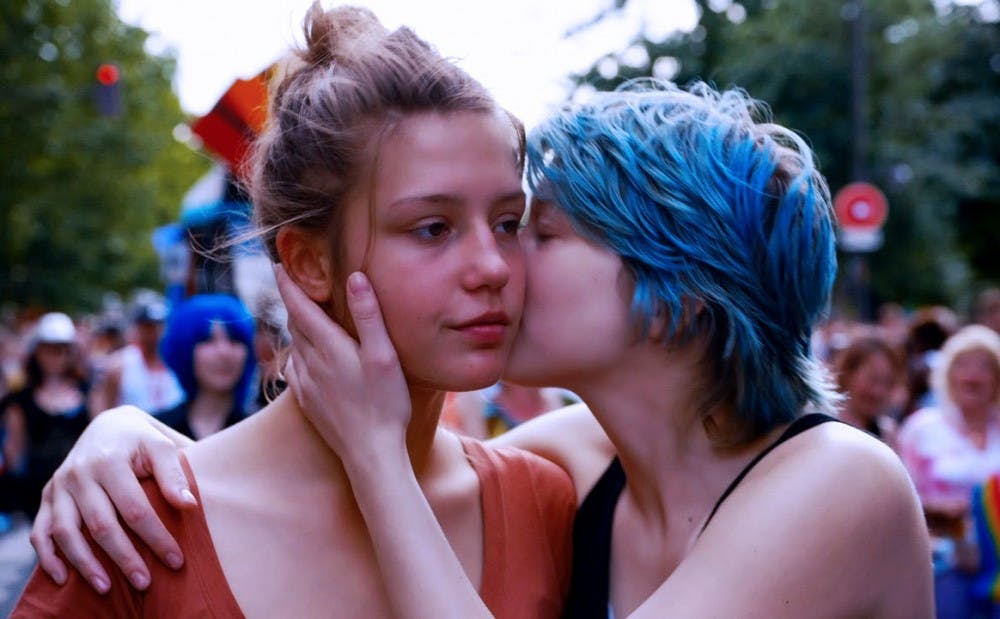4/5 stars
Dir. Abdellatif Kechiche
Sundance Selects
Before its large-scale release, there was already tremendous hype for “Blue is the Warmest Color.” In May, the film premiered at the Cannes Film Festival where, for the first time, the Palme D’Or was awarded not only to the director Abdellatif Kechiche ("The Secret of the Grain") but also the two lead actresses, Léa Seydoux and Adèle Exarchopoulos, an unprecedented but ultimately justified move. Exarchopoulos and Seydoux, respectively playing the main character Adèle and the love interest Emma, were both outstanding, displaying so much passion and emotion that the film is sometimes uncomfortable to watch. Both actresses later admitted that the process of making the film was horrible due to how much Kechiche made them give emotionally at all times, even forcing them to physically hit each other and refusing to choreograph the sex scenes.
The movie chronicles the life of Adèle, who starts off as a confused high school student not content with her boyfriend and other friends. Eventually she meets and falls in love with the somewhat older, blue-haired artist, Emma. The rest of the movie follows Adèle’s experiences with love, identity, confusion, heartbreak and loneliness.
The cinematography by Sofian El Fani is absolutely stunning. Similarly, but less obtrusively than in Krzysztof Kieslowski’s “Bleu,” the film is filled with the color blue. Blue is prevalent in many obvious and symbolic ways, such as the color of Emma’s hair, and in much more subtle aspects such as a deep blue nail polish or a bright blue shirt worn by someone walking in the background. All of the blue creates a mesmerizing, dream-like atmosphere that is terrifically easy to get lost in.
While blue is important in the film, the French title of the film, “La Vie D’ Adèle: Chapitres 1 & 2,” seems to be more appropriate. The movie is about so much more than the various potential interpretations of all the blue in the film; it is about Adèle during two chapters of her life—potentially the pre-Emma and Emma chapters. The film is not concerned with unimportant and unnecessary plot events, often skipping over them, but rather focuses on events that are important to Adèle emotionally. After a crucial moment in which a fight breaks out one morning before school, we never see Adèle return to her school, but we soon see her working her dream job without any intermediary explanation. Part of the brilliance behind Exarchopoulos’s performance is how well she is able to tell the story with just her face, in all its aspects: lips, nose, eyes, cheeks—even how she puts up and down her hair—work in harmony to express what Adèle is feeling and experiencing. Her lips alone are able to tell the entire story as they quiver, kiss, laugh, eat or remain motionless and slightly agape, almost as well as Maria Falconetti’s eyes are able to in “The Passion of Joan of Arc.”
One of the greatest aspects of the film is its ability to feel completely familiar and radically new at the same time. The film deals with love and growing up but does so in a way that is far more immersive and realistic than many films dare to go. Walking out of the three-hour film is more reminiscent of waking up from a detailed blue-tinted dream than leaving a movie.
As expected, there has been much controversy over the extended and explicit sex scenes in the movie. These scenes are not pornographic filth as some deem them, but are integral for Kechiche to accomplish his goal of portraying the process of growing up and falling in love. Unlike most sex scenes that serve simply as a means to the end of plot development, the scenes here are ends in themselves to explore the role of sex and intimacy in a relationship and how they diverge from public life.
Throughout the film, Kechiche is able to assert the film’s relevance and importance while mirroring what is happening through Adèle’s relationship to literature. In the beginning, Adèle is in a class that prophetically discusses “La Vie de Marianne” and how it relates to the nature of love and the idea of love at first sight, showing art’s relatability to life. In the middle of the film, Emma and Adèle discuss Sartre when Emma says that she was big on Sartre in high school since he allowed her to accept who she was, showing art’s ability to affirm and comfort. Finally, near the end of the film, in what can be seen as a cry of victory from Kechiche, Adèle reads a poem to her class of first graders that ends by praising the almost limitless power wielded exclusively by the artist.
A film largely about a homosexual couple, especially when the director and lead actresses are heterosexual, is bound to elicit scrutiny over political incorrectness or simple naiveté. There are certain faults with the film, such as Kechiche’s disappointingly strong “male gaze,” objectifying women by portraying them as a set of body parts as opposed to a human being. That said, it is refreshing that while a large part of the film deals with Adèle falling in love with another woman, Emma, the film is able to resist being defined by that fact and does not posit a cursory, black-and-white view of sexuality.
Get The Chronicle straight to your inbox
Signup for our weekly newsletter. Cancel at any time.

